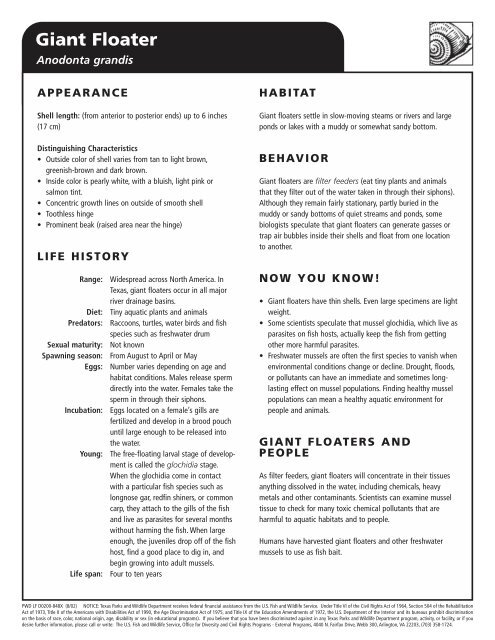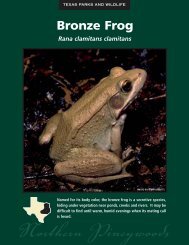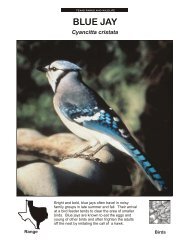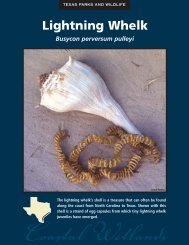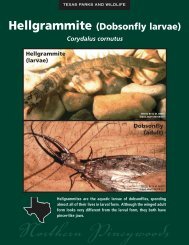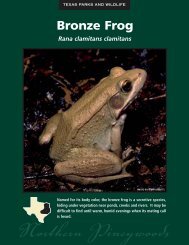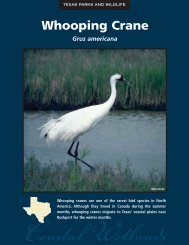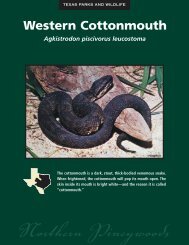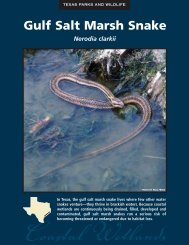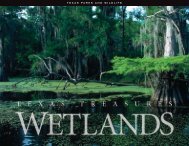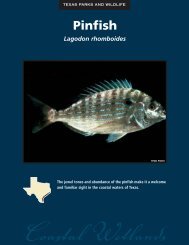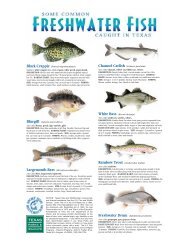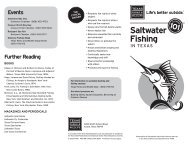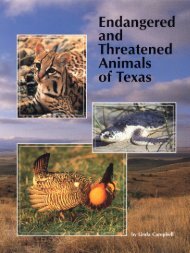Giant Floater - The State of Water
Giant Floater - The State of Water
Giant Floater - The State of Water
Create successful ePaper yourself
Turn your PDF publications into a flip-book with our unique Google optimized e-Paper software.
<strong>Giant</strong> <strong>Floater</strong><br />
Anodonta grandis<br />
APPEARANCE<br />
Shell length: (from anterior to posterior ends) up to 6 inches<br />
(17 cm)<br />
Distinguishing Characteristics<br />
• Outside color <strong>of</strong> shell varies from tan to light brown,<br />
greenish-brown and dark brown.<br />
• Inside color is pearly white, with a bluish, light pink or<br />
salmon tint.<br />
• Concentric growth lines on outside <strong>of</strong> smooth shell<br />
• Toothless hinge<br />
• Prominent beak (raised area near the hinge)<br />
LIFE HISTORY<br />
HABITAT<br />
<strong>Giant</strong> floaters settle in slow-moving steams or rivers and large<br />
ponds or lakes with a muddy or somewhat sandy bottom.<br />
BEHAVIOR<br />
<strong>Giant</strong> floaters are filter feeders (eat tiny plants and animals<br />
that they filter out <strong>of</strong> the water taken in through their siphons).<br />
Although they remain fairly stationary, partly buried in the<br />
muddy or sandy bottoms <strong>of</strong> quiet streams and ponds, some<br />
biologists speculate that giant floaters can generate gasses or<br />
trap air bubbles inside their shells and float from one location<br />
to another.<br />
Range:<br />
Diet:<br />
Predators:<br />
Sexual maturity:<br />
Spawning season:<br />
Eggs:<br />
Incubation:<br />
Young:<br />
Life span:<br />
Widespread across North America. In<br />
Texas, giant floaters occur in all major<br />
river drainage basins.<br />
Tiny aquatic plants and animals<br />
Raccoons, turtles, water birds and fish<br />
species such as freshwater drum<br />
Not known<br />
From August to April or May<br />
Number varies depending on age and<br />
habitat conditions. Males release sperm<br />
directly into the water. Females take the<br />
sperm in through their siphons.<br />
Eggs located on a female’s gills are<br />
fertilized and develop in a brood pouch<br />
until large enough to be released into<br />
the water.<br />
<strong>The</strong> free-floating larval stage <strong>of</strong> development<br />
is called the glochidia stage.<br />
When the glochidia come in contact<br />
with a particular fish species such as<br />
longnose gar, redfin shiners, or common<br />
carp, they attach to the gills <strong>of</strong> the fish<br />
and live as parasites for several months<br />
without harming the fish. When large<br />
enough, the juveniles drop <strong>of</strong>f <strong>of</strong> the fish<br />
host, find a good place to dig in, and<br />
begin growing into adult mussels.<br />
Four to ten years<br />
NOW YOU KNOW!<br />
• <strong>Giant</strong> floaters have thin shells. Even large specimens are light<br />
weight.<br />
• Some scientists speculate that mussel glochidia, which live as<br />
parasites on fish hosts, actually keep the fish from getting<br />
other more harmful parasites.<br />
• Freshwater mussels are <strong>of</strong>ten the first species to vanish when<br />
environmental conditions change or decline. Drought, floods,<br />
or pollutants can have an immediate and sometimes longlasting<br />
effect on mussel populations. Finding healthy mussel<br />
populations can mean a healthy aquatic environment for<br />
people and animals.<br />
GIANT FLOATERS AND<br />
PEOPLE<br />
As filter feeders, giant floaters will concentrate in their tissues<br />
anything dissolved in the water, including chemicals, heavy<br />
metals and other contaminants. Scientists can examine mussel<br />
tissue to check for many toxic chemical pollutants that are<br />
harmful to aquatic habitats and to people.<br />
Humans have harvested giant floaters and other freshwater<br />
mussels to use as fish bait.<br />
PWD LF D0200-848X (8/02) NOTICE: Texas Parks and Wildlife Department receives federal financial assistance from the U.S. Fish and Wildlife Service. Under Title VI <strong>of</strong> the Civil Rights Act <strong>of</strong> 1964, Section 504 <strong>of</strong> the Rehabilitation<br />
Act <strong>of</strong> 1973, Title II <strong>of</strong> the Americans with Disabilities Act <strong>of</strong> 1990, the Age Discrimination Act <strong>of</strong> 1975, and Title IX <strong>of</strong> the Education Amendments <strong>of</strong> 1972, the U.S. Department <strong>of</strong> the Interior and its bureaus prohibit discrimination<br />
on the basis <strong>of</strong> race, color, national origin, age, disability or sex (in educational programs). If you believe that you have been discriminated against in any Texas Parks and Wildlife Department program, activity, or facility, or if you<br />
desire further information, please call or write: <strong>The</strong> U.S. Fish and Wildlife Service, Office for Diversity and Civil Rights Programs - External Programs, 4040 N. Fairfax Drive, Webb 300, Arlington, VA 22203, (703) 358-1724.


